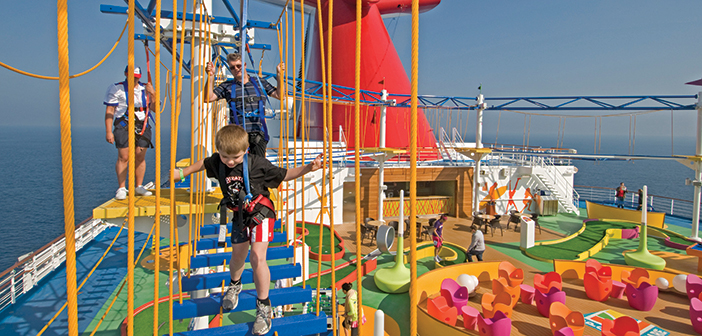Founded in 1989 as Ropes Courses Inc., RCI Adventure Products has grown far beyond building ropes courses to manufacturing and constructing a wide variety of adventure park experiences. Eschewing wood for steel, and wooded lots for settings that include everything from theme parks and restaurants to retail stores and cruise ships, RCI’s diversified and branded product line includes Sky Trail vertical ropes courses, Sky Tykes play areas, Sky Rail aerial rides, Clip ‘n Climb climbing towers, netted (and unclipped) Adventure Trails, and Amaze’n Mazes, a modular maze-building system.
Founders Jim and Michelle Liggett added operations to their plate more than a decade ago, lending their name to a string of LiggettVille owned and operated adventure parks—all built and supplied by RCI, of course.
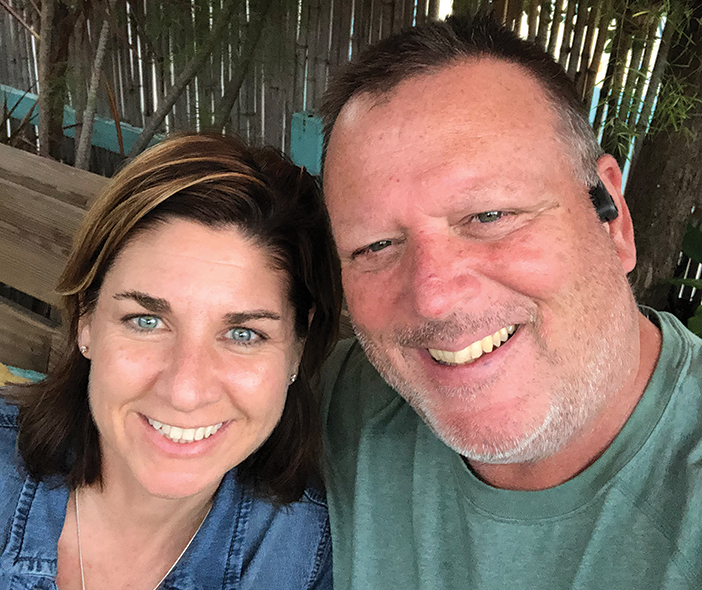
Jim and Michelle Liggett of RCI Adventure Products.
Like many in the industry, Jim was first exposed to ropes courses at summer camp back in the early ’80s. He helped build his first course when he was 19, and incorporated a course-building business with a friend shortly there-
after. They were paid in food, not
money, for the first three courses they built, and business grew from there.
Jim left the business a few years later and took a job pumping gas while figuring out what to do next, but the phone kept ringing from people who wanted him to build them a ropes course. “So, I kept building, and then I said, ‘Hey, there’s something to this,’” Jim recalled. That’s when he started Ropes Courses Inc.
API recently chatted with Jim about the company, bringing ropes courses to the masses, and how his products have become almost as common on Caribbean cruises as buffet lines and sun decks.
API: What would you consider your first big project?
Liggett: I don’t know. There’s just been so many we built. I may have built over a thousand ropes courses. It’s like somebody asking, “How many beers have you had?” I don’t know.
Most of the ropes courses were in the woods and weren’t open to the public; you did their program and left. I had been on the road building 150 to 200 days a year for 15 years. I was tired of that, and I wanted to take ropes courses to the public. And I got nothing but backlash because [traditionalists]thought of that as a bastardization of ropes courses. Now, everybody does it, and they come to me and say, “Oh, that was a great idea.” I was the first one to build double-deck and triple-deck ropes courses, and to build octagon platforms that you can walk all the way around. Of course, everybody does that nowadays.

Left to right: Twisted Trail Zip Rail ropes course at Natural Bridge Caverns, Texas; netted Adventure Trail at Cedar Point, Ohio; on course at Natural Bridge Caverns.
API: You filed your first patent around the same time you started building public courses, right?
Liggett: With the safety systems back then, there was a cable above every element—you unclip and then clip to another—and I knew that that was just not doable for the public. That was a total unclip. Just because they unclip both of them doesn’t mean they immediately fell to the ground and died, of course, but I knew I would have to develop a safety system that anybody could use and that you could move around and never become unclipped. So, about 23 years ago, I did my very first patent, called Track and Trail, and that was the first safety system for ropes courses that you could get hooked in and go around the entire course.
API: How did always being on the road encourage your switch from building with wood to using steel?
Liggett: I never felt comfortable letting anybody do the work except under my direct supervision, so I was on site for every damn job. And I thought, the only way to change that is if I make it out of steel, because there’s a lot of people who can put bolts in holes and tighten them. And I can control the quality assurance and the safety in the shop, and then I can ship them and be done with them. Make sure somebody inspects it, or I go inspect it for a day instead of being on site for two weeks.
That’s where our paradigm shifted. I invented and patented the Sky Trail about 22, 23 years ago, and I started getting into some family entertainment centers, where people could charge $5 or $10 to go through a ropes course. Take the money, hook them in, and say, “Go play.”
The first real one that was successful was Stone Mountain, Ga. I’ll never forget it. I think they paid us $385,000 to build the course and did $2.2 million in business the first year.
API: How did you build the business into what it is today?
Liggett: With Stone Mountain—and they’re still a customer—I realized I could change my pricing from what it costs to make, to what it makes. That was really the game changer on the economics of ropes courses. In the beginning, you just needed a few thousand dollars of tools and you could be in business. Now, we have a 150,000-square-foot manufacturing facility.
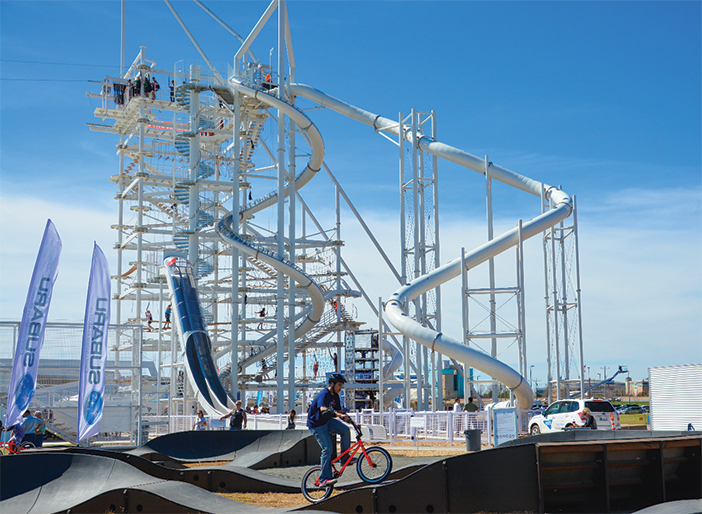
Explorer tower at the Oklahoma City Boathouse, Okla.
I started with a damn rusty Blazer and a big heart, but every journey starts somewhere. The reason I could build a business is because my wife ran the business part and I went and did the lifting. I was built for moving stuff, and she was built for crunching numbers. Michelle, without her being there running the business, I wouldn’t have one. She’s the heart of the empire.
API: You had this successful business building courses; what made you decide to get into the operations side?
Liggett: The economics on operations are so much better than the economics on manufacturing. We opened one in Connecticut, in a Jordan’s Furniture store. We put in a ropes course and it was wildly successful. It was incredible. So, they convinced us to do a second one that was quite a bit bigger—the world’s largest indoor ropes course. We did more than $2 million the first year of operations there. And at that point, it hit me upside the head that there’s more money in operations than manufacturing and a lot less risk. You know, the story of RCI is also the story of LiggettVille; their continued growth goes hand-in-hand.
API: What’s the scope of your business now?
Liggett: We’re having our best year ever. We’re probably doing $30 million to $35 million in business this year. But you never know. That could end tomorrow. I went from 120 employees to 11 during Covid. Now we have 72, and we’re doing 20 percent more work. We closed one shop and bought equipment that helps us work more efficiently. When you come to work every day for a year and don’t know if you’re going to have a business, it really just gives you time to stop and think about how you can be better.
API: You mentioned that you have these rustic roots just like everyone else, but you’re much more rooted in the amusement park industry than the outdoors industry at this point. Tell us about that transition.
Liggett: Well, it’s an amusement ride. I was a pioneer, so I took the arrows. My goal was to give it to the masses; a lot of other people’s goal was to control it. I mean, you’re still being active, you’re still clipping in. I could never forget the first time I ever went on a ropes course. I felt incredible being in the air. Now, I think we do almost 30 million people a year on our product—they can pay 15 bucks and be in the air. That’s crazy. I did that.
API: Does something get lost when you take the risk away?
Liggett: Define “risky.” You’re up in the air. You’re looking down. There are two inborn fears: one is a fear of loud noises, and then there’s that fear of falling. People still get that thrill, despite all the safety innovations that have come along. The perception of risk is what makes it a ropes course. You’re still getting all that on the Sky Trail.
It’s a different kind of experience on the Adventure Trail. You’re crawling and exploring in there. It’s basically a playground. That’s a product we purchased from another company. We’ve been building those. We did two of them for a million bucks apiece and just sold four more—it’s going to be a big part of our product line.
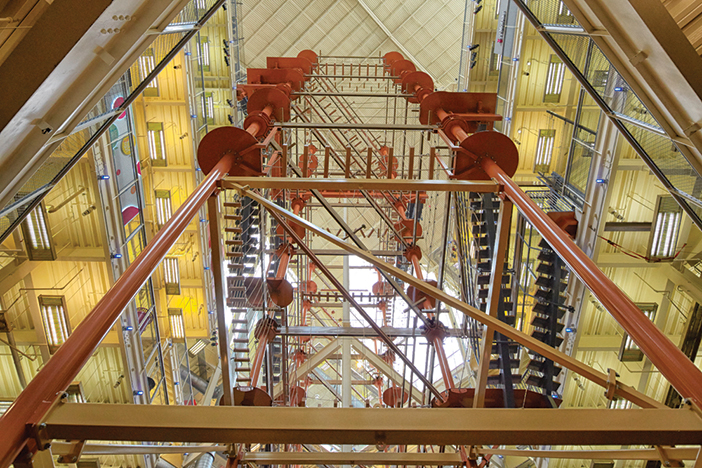
Five-level Explorer tower in the Palisades Mall, N.Y.
That’s why we changed the name of the company a couple of years ago from Ropes Courses Inc. to RCI Adventure Products, because we now do the Adventure Trail, mazes, climbing walls, Sky Tykes. We have the new Li’l Zippers, which is the first canopy tour for kids under age 7—it’s a full canopy tour using Sky Rails, and it’s all controlled by computer. We have a larger one for ages 7 and up that functions the same way. It doesn’t take any staff, so it’s zero labor. It’s all automated: Each rail is programmed with a full system that won’t let you go ’til everybody’s out of the way.
API: There’s a perception that RCI’s systems are a lot more off-the-shelf than custom. Is that accurate?
Liggett: You know, I wish. We tried to make them off the shelf. It does not work. Every single environment, location, customer has different demands. I don’t know that we’ve ever sold two of the same courses ever. Some have different wind loading. Some are in earthquake zones. Nothing’s exactly the same. Do we use a lot of the same parts? Sure.
API: In the amusement park industry there’s always an arms race about who can build the tallest, fastest, biggest roller coaster. Is the same dynamic at work in this industry?
Liggett: Yeah, there is. But I’m not racing against anybody except myself. I mean, these jackasses that copy me, they’re still six years behind. They don’t understand the product and why it works. They understand there’s a beam, there’s a track. So, they get 50 or 60 percent of the way there, but they don’t understand the why and how, so they’ll just go on the web and steal your training manuals.
But they do me a great favor: They take the cheap people. And you know what, cheap people cost you as a business. It’s horrendous, because they’ve always got a problem. They’ve always got a thing. It’s always your fault.

Left to right: Taking the Weave Walk on LiggettVille’s indoor Sky Trail at Allegan Event Center, Mich.; The Island at Pigeon Forge, Tenn.; Voyager element at a park in South Korea.
But the people with money, they’re the problem-solvers. They know how to make money, because they already made money. Most of the people that buy from us are buying their second or third or fourth course. We’ve got one customer that has 35 courses. So, the imitators are doing me a favor, and they can choke on all the people that want to save a dollar.
API: You’ve installed courses in some fascinating locations, including cruise ships, restaurants, and as we discussed earlier, a furniture store. How did you get into all these places?
Liggett: Funny story about that: We got a call from a cruise line, we sent them our design and the first thing they did was shop the design to everybody (laughs). But it worked out fine, and now they’re our best customer.
The cruise lines are crazy because they are choosing to work in the harshest environment. We just did our twenty-seventh cruise ship. Norwegian let us do a Sky Rail where you walk the plank off the edge of the ship, then they take a picture and sell it to you for $20. And they do 1,000 people a day, and as long as we can continue to create new elements and make a “wow,” they’re going to continue to buy them.
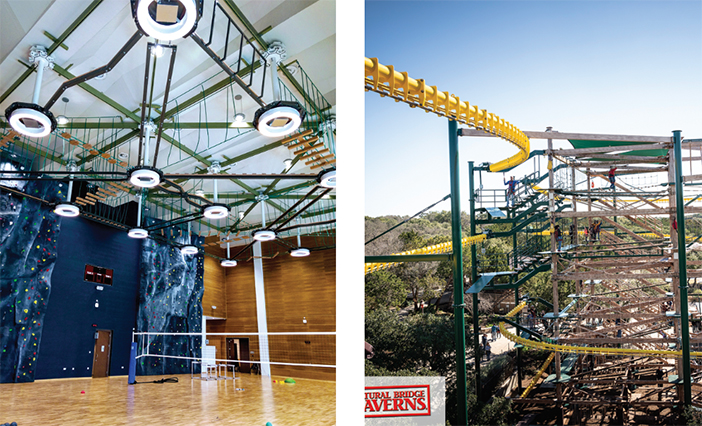
Left: A suspended Sky Trail at a drug rehab center in Oman. Right: On the Sky Rail at Natural Bridge Caverns, Texas.
With [restauranteur]Lucy Buffett, they bought a course from us, put it up, and then just have a ropes course at the restaurant. We got a lot of restaurants where there’s a waiting time. A ropes course fits in perfect. There’s an outdoor bar, so the kids play on the ropes course while the parents sit and drink. We put one on top of a building in a mall, we’re in Mall of America, Disney Shanghai.
API: How does Amaze’n Mazes fit into the business?
Liggett: It fits our profile, which is high-throughput, low-staff, and family-friendly. It’s a good product for us because it’s not very expensive, and it’s unique. It only takes one person to run. You only have to charge a few bucks for it. Another part of the reason we bought the maze company was that all of our clients were buying them and putting them underneath our product (laughs).
API: Is the maze your lowest entry point product?
Liggett: The mazes cost about $120,000. Our lowest entry point right now is a new Sky Tykes with four elements and a Sky Rail, and that’s about $50,000-$60,000. An entry-level ropes course is about $120,000. But the price doesn’t matter. What matters is how fast you get your money back.
API: How much of your business growth has been via acquisition?
Liggett: In addition to the mazes and Adventure Trail, we bought a license for Clip ‘n Climb because we decided we wanted to have a climbing wall product, and we sold 350 of them in the first three years. People who buy a ropes course buy a dozen walls. Add a canopy tour to it, and all of a sudden, we’re able to sell an entire environment.
API: What do you see for the future of your companies and the industry?
Liggett: I think every single one of our product lines will just keep getting deeper and deeper with electronics and lights, bells and buzzers and whistles. Fully integrated safety systems integrated with computers that make things more reportable. I’m not sure courses will get higher—higher and bigger isn’t necessarily better, because there’s only so high people will go. It’s more about quality. Making the elements between the platforms a better experience is really what we’re after.
What drives me is the safety, and the innovation to make the experience, and also to stay on top. Billion-dollar companies don’t call anybody but us. They have to call us because we’re the company that puts 30 million people in the air, and they can’t take a risk with anyone else.


